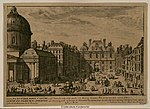Maxim's
1893 establishments in FranceArt Nouveau architecture in ParisArt Nouveau restaurantsBuildings and structures in the 8th arrondissement of ParisRestaurants in Paris

Maxim's is a restaurant in Paris, France, located at No. 3 rue Royale in the 8th arrondissement. It is known for its Art Nouveau interior decor. In the mid 20th century Maxim's was regarded as the most famous restaurant in the world.
Excerpt from the Wikipedia article Maxim's (License: CC BY-SA 3.0, Authors, Images).Maxim's
Rue Royale, Paris 8th Arrondissement of Paris (Paris)
Geographical coordinates (GPS) Address Nearby Places Show on map
Geographical coordinates (GPS)
| Latitude | Longitude |
|---|---|
| N 48.8675 ° | E 2.3225 ° |
Address
Rue Royale 7
75008 Paris, 8th Arrondissement of Paris (Paris)
Ile-de-France, France
Open on Google Maps







